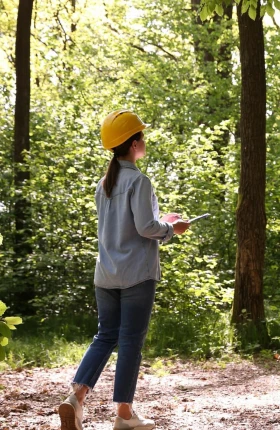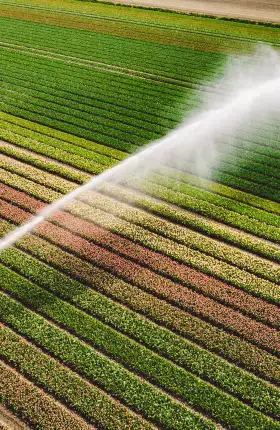The demand for carbon removal continues to rise as corporate efforts to get to net zero and mitigate climate change intensify. The voluntary carbon market (VCM) grew fourfold in value from 2020 to 2021, reaching $2 billion, and it is expected to grow to between $10 billion and $40 billion by 2030. As the market develops, it is also evolving to focus more on the quality of carbon sequestration—such as through permanence and transparent evaluation of carbon credits—rather than just its volume. Increasingly, sophisticated buyers will pay for these improvements.
This article explores how new approaches to soil carbon sequestration can deliver a significantly higher quantity of carbon removal with higher permanence. Recent research indicates that the potential for storing carbon in soil is greater than previously believed, with the potential to sequester 5 gigatons of CO2 annually until 2050. This means that soil could play an outsize role in carbon markets. Alongside emerging solutions, registries and project developers are focusing on using new measurement, reporting, and verification (MRV) methodologies that cater to these new carbon dioxide removal (CDR) techniques. This will help speed their deployment.
Defining Next-Gen Soil Carbon
Today, soil as a carbon sink is discussed primarily in the context of regenerative agriculture practices. But practices such as no till or reduced till and cover cropping have faced skepticism for several reasons:
- Long transition times from traditional farming to regenerative practices, low carbon yields, and high switching costs create barriers to large-scale farmer adoption.
- Current MRV methods lack transparency and detailed data, which carbon credit buyers increasingly demand.
- Carbon sequestered in the soil is currently perceived as vulnerable to reversal, leading to doubts about its permanence.
Next-gen soil carbon sequestration—a set of carbon removal methods that use soil additives—promises to reshape the industry. Unlike the familiar regenerative farming practices, these additives supercharge biological and chemical processes that naturally occur in the soil, thereby enabling superior carbon removal as well as a range of other benefits (such as improved crop yields, water and nutrient uptake, crop resilience, and improved biodiversity). There are three distinct categories of next-gen soil carbon: enhanced rock weathering, biochar, and microbials. All three can help resolve the issues that are inherent in transitioning to regenerative agriculture practices.
Next-gen soil carbon sequestration—a set of carbon removal methods that use soil additives—promises to reshape the industry.
According to science- and data-based MRV (as opposed to MRV based on historical sequestration and modeling), these three next-gen methods can deliver higher permanence and superior efficacy. In fact, they can sequester 3 to 4 tons of CO2 per acre, while standard regenerative agriculture practices might yield 0.5 to 0.7 tons of CO2 per acre. These benefits are attracting a range of new next-gen soil players. (See “Innovators in Next-Gen Soil Sequestration.”)
Innovators in Next-Gen Soil Sequestration
Groundwork BioAg. The company uses a mycorrhizal inoculant to strengthen plant root systems for more efficient nutrient uptake. Mycorrhizal fungi are the foundation of healthy soil and the main pathway for new carbon to enter into the soil. They supercharge the efficacy of soil carbon sequestration and convert it into mineral-associated organic carbon and glomalin-related soil protein, which have been identified for their ability to persist in soil for millennia.
Myland. The company has a “soil as a service” offering that involves extracting live, native microalgae directly from each farm’s soil. Then it rapidly reproduces those microalgae in mass quantities onsite and delivers them in living form back into the soil through the farm’s irrigation system, where the microalgae continue to multiply. The continuous delivery of microalgae improves the physical, chemical, and biological traits of the soil. This process has reduced the need for fertilizer, tillage, and water by more than 30%, has improved yield by 15% to 30%, and increased revenue by 25% to 50%. The company’s methodologies are being used across much of the US for different crop varieties.
Andes. The company leverages naturally occurring microorganisms and existing farming operations to sequester CO₂ into minerals on agricultural land in the US. Its microbial solution can increase water permeability, aeration, and nutrient availability, leading to healthier crops and soils. Andes’ carbon removal program enables farmers to increase their net income from operations by up to 25%. Its methodology (developed with third parties) serves as a transparent blueprint for quantifying and crediting microbial carbon mineralization. The company claims to have removed more than 100,000 tons of CO₂, with plans to reach megaton scale as soon as 2026.
Net Zero. The company’s goal is to scale biochar in tropical countries. It operates a circular model using agriculture residues as feedstock and returning biochar to the same farmers supplying the biomass. Its model allows them to remove carbon from the atmosphere for millennia while improving local agriculture through higher yields, lower fertilizer use, and crop resilience. Net Zero has developed three biochar plants in Cameroon and Brazil with a commitment to sell credits to vetted companies with serious net zero commitments.
UNDO Carbon. The company’s method is to spread crushed silicate rock such as basalt on agriculture land, permanently removing CO₂ from the atmosphere for at least 100,000 years. The process improves soil biology and soil fertility and supports shell formation in marine life. Based in the UK with operations in Canada and Australia, the company is working to scale its solution. To date, it has spread 176,000 tons of rock across more than 10,000 hectares globally at 180 farms, removing more than 46,000 tons of CO₂ from the atmosphere.
Enhanced Rock Weathering. Enhanced weathering enables sequestration through CO2 mineralization, creating the highest permanence among next-gen soil carbon methods. Studies suggest that it offers more than 1,000 years of durability. In terms of efficacy, results are not yet conclusive, but studies point to approximately 3 to 4 tons of CO2 per acre sequestered, depending on factors such as the amount of crushed rock applied to soils. The main challenges for enhanced weathering are reliable and robust MRV, scientifically proven sequestration claims, and scalability, since soils with certain pH levels are less suitable for enhanced rock weathering.
Biochar. Biochar also demonstrates high permanence, with research suggesting that a large percentage of biochar carbon sinks (75%) can persist in soil for centuries, while the remaining 25% has a mean permanence of more than 100 years. Biochar offers strong sequestration efficacy, with each ton of biochar able to sequester approximately 3 tons of CO2 per acre. Since about 2 to 3 tons of biochar is recommended per acre, the total sequestering potential per acre is approximately 5 to 10 tons of CO2. The main challenges biochar raises are proving net positive impact and ensuring sustainability of feedstock (typically a byproduct of heavy industrial and carbon-intensive processes). Even so, biochar is the most established of the next-gen soil techniques and already commands a price of $100 to $115 per ton, while the median price for traditional soil carbon is around $25 to $30 per ton.
Microbials. Microbials refer to beneficial microorganisms, such as bacteria, fungi, and other microbes, that are introduced into the soil to enhance fertility, nutrient cycling, and overall health, thereby improving carbon sequestration. Although permanence varies by method, many microbial methods do increase recalcitrant soil carbon (a more durable form of organic soil carbon) and can even facilitate carbon mineralization in the soil leading to inorganic soil carbon. For example, mycorrhizal inoculation can sequester up to 4 tons of Co2 per acre, of which up to 2.8 tons of CO2 per acre is considered permanent. Glomalin-related soil protein is considered recalcitrant and stable in the soil for decades, and mineral-associated organic carbon is known to persist in soil for millennia. In terms of efficacy, microbials also trump traditional soil carbon, with many microbial methods able to sequester up to 10 tons of CO2 per acre.
Faster Outcomes
Traditionally, when farmers transition from conventional agriculture to regenerative agriculture practices, they must wait two to five years before carbon sequestration is sufficient to generate carbon credits and soil co-benefits. This long transition time creates high switching costs. But next-gen soil carbon methods can shorten the timeline. In particular, microbial methods accelerate organic soil formation processes by adding biological agents, whereas regenerative agriculture practices merely allow these organic processes to take place. Positive results are possible within a year.
Increased Scalability
On top of permanence and co-benefits, next-gen soil carbon methods also improve the scalability of carbon soil sequestration thanks to higher efficacy, better economics for farmers, and a lower burden to change (including transition time and cost). The scalability of each next-gen soil carbon method depends on many factors, including the availability of feedstock and the amount of cropland and crop types. For example, mycorrhizal inoculation is highly scalable because it is suitable for both conventional and regenerative farming and can be applied to 90% of all crops. Similar scalability benefits have been observed with other microbials.
New Registries and Verification Methods
Changes to MRV are starting to help unlock the potential of these next-gen soil methods. The part of MRV that relates to verifying and registering projects has traditionally been in the hands of several large nonprofit carbon credit registries. These registries established their own standards to certify and verify the integrity of carbon offsets, and they focus on nature-based credits across project types (such as reforestation and soil carbon). But their verification rules require project developers to align with an existing methodology—a one-size-fits-all approach that does not suit innovative, next-gen soil carbon methods. This has created long lead times to market and unnecessary costs (excessive buffer pools or control plot requirements, for example).
In response, a new generation of carbon credit registries is emerging to support faster deployment of innovative, high-quality CDR solutions. Such companies are commercially oriented and use scientific expertise to work with CDR innovators—such as next-gen soil carbon—to develop verification methods and increase speed to market.
For example, Puro.earth, a crediting platform for engineering carbon removal, has successfully pioneered five methodologies (including biochar and enhanced rock weathering) and is being endorsed by the International Carbon Reduction and Offset Alliance. The company has a network of 175 suppliers and collaborates with 40 reseller partners. To date, Puro.earth has certified more than half a million credits of removal with 254,000 credits to corporate buyers.
A new generation of carbon credit registries is emerging to support faster deployment of innovative, high-quality carbon dioxide removal solutions.
Isometric is another player entering this space. It is looking to simplify the buying experience and help scale CDR by creating a registry that’s open directly to buyers. To create high-quality credits, the company is focused on using science-based protocols to validate carbon removal. Data transparency is key to building confidence in credit quality.
Beyond Carbon Markets: The Insetting Opportunity
These developments in the carbon market also create an opportunity for big companies that contract with farmers to reduce their own scope 3 emissions. In fact, food and beverage and agriculture companies can especially benefit from using next-gen soil carbon methods. Among all industries, companies in these two fields have some of the highest share of scope 3 emissions. For them, deploying next-gen soil carbon methods to maximize carbon removal while optimizing farmer yields in a shorter timeframe is an intriguing new strategy. For companies that want to shift from offsetting their carbon footprint to “insetting,” or reducing their scope 3 carbon footprints, this strategy can lead to superior results in both carbon reduction and farmer benefits.
Next-gen methods such as biochar, enhanced rock weathering, and microbials enable breakthrough levels of carbon sequestration and co-benefits while improving permanence, quality, and scalability. Crucially, these advancements are possible in the near term and can help project developers and growers overcome many of the challenges related to traditional, regenerative farming.
Our planet’s soils hold immense potential for carbon sequestration, making next-gen soil carbon a key element in getting to net zero. We urge leaders to examine the role of high-quality soil carbon removal as part of their carbon credit portfolios.






